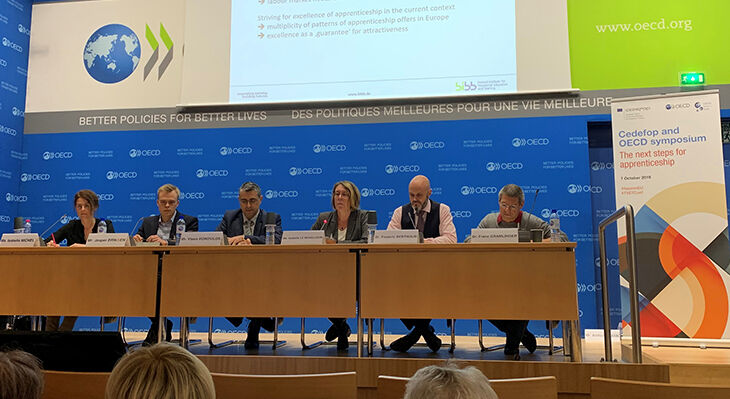What’s the future of apprenticeships in Europe going to look like?
Researchers from the field of economics and education alike are interested in the motivation with regard to recruitment functions, the organisation of work-based learning and the wider benefits and outcomes of such an engagement of firms in formal education. On October 7, 2019, Cedefop and OECD invited international experts of both fields to Paris to discuss “the next steps for apprenticeship”. Head of division Isabelle Le Mouillour and Dr. Philipp Grollmann represented the BIBB at the symposium.

In the aftermath of the global financial and economic crisis of the late 2000s, national governments in Europe have increasingly worked on the development of work-based learning and apprenticeship programmes in order to facilitate the transition from school to work for the young generation. Across Europe different approaches are employed varying between school-based programmes, enterprise training and professional education and training to which the German dual system belongs. Strikingly, the logic of professional education and training dominates our image of apprenticeship in Europe due to the huge number of apprentices that participate in those programmes in Austria, Denmark, Germany, Norway, Poland and Switzerland. However, the major share of European countries offer predominately school-based programmes.
Together with Dr. Jörg Markowitsch, senior partner at 3s Research Laboratory in Vienna, Dr. Grollmann presented three potential scenarios of the future of apprenticeships in Europe based on the following research questions:
- What is the focus and design of institutionalised apprenticeship programmes?
- In how far are firms willing to train and to be involved in the design and delivery of educational programmes?
- Which role and value will society attach to vocational education in the future compared to other forms of workbased learning?
In the “Fake” scenario apprenticeships and on-the-job learning are reduced to their very essentials for the respective single job and apprentices end up in low-skilled jobs filling vacancies at the margins.
In the “Brand” scenario the institutionalised VET system offers apprenticeship programmes that foster educational goals, vocational learning and the integration into the labour market. Actors from education and economy alike shape the system. It is aligned with employers’ broad and complex skill needs.
The “Label” scenario comes with a wide spectrum of organisational practices that coexist. Depending on the motivation of the respective promoter, the logic of apprenticeship varies between pure enterprise training, school-based education and active labour market policies.
In conclusion, the recent developments in Europe might support the “Label” scenario at the expense of the “Brand” scenario.
European vocational education and training in terms of excellence
The development of excellence in vocational training is a task to which the institutions of the European Union have committed for the coming years. BIBB head of division Isabelle Le Mouillour and colleagues from Austria, Denmark and Switzerland compared their respective apprenticeship systems with regard to the question of which specific policy initiatives need to be taken in order to improve the quality of the systems.
Ms Le Mouillour, Dr. Frédéric Berthoud, from the Swiss State Secretariat for Education, Research and Innovation, and Dr. Franz Gramlinger from the Austrian Reference Point for Quality Assurance in Vocational Education and Training focused in their contribution on the meaning of excellence in apprenticeship systems and presented current initiatives in Germany, Switzerland, Austria and Denmark. To their mind, excellence is a mean to increase the attractiveness of apprenticeship and includes fostering innovation, inclusion and applied research.
Together with other European partners, the Federal Institute for Vocational Education and Training has worked on this subject e.g. within the framework of the project “Apprenticeship Toolbox”. In advance of the conference, the toolbox - which was developed in 2017 - was updated and thus formed the basis for the contribution.
Download the presentation here